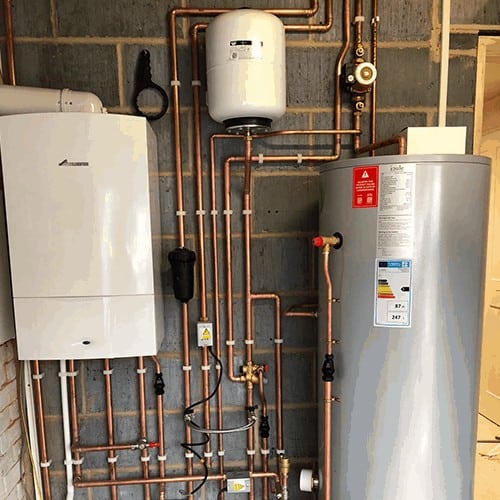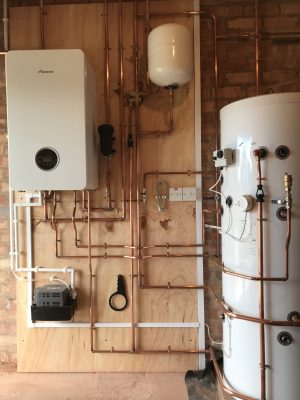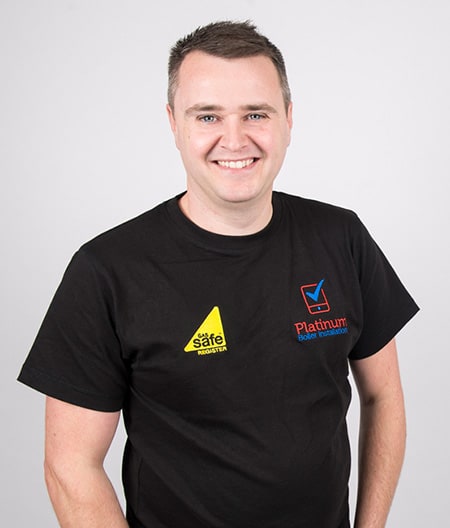
A vented cylinder is the more traditional cylinder you will most likely have seen. They are normally made from copper and fed via a large cold water cistern tank in the loft space. The water is gravity fed from the tank to the cylinder. They are installed with a vent pipe, which terminates into the tank in the loft. This allows for expansion as the water is heated, hence the name 'vented cylinder'.
An Unvented Cylinder is fed directly from the cold main supply, so there is no need for a tank in the loft space. As they are fed directly from the cold main supply, the pressure and flow rate will be far superior. This is why it is vitally important to check your incoming cold water main supply.
Unlike vented cylinders, there is no vent pipe or tank on an unvented cylinder to cope with the expansion as the water is heated. To get over this, unvented cylinders have an expansion vessel, or an internal air gap within the cylinder, to allow for the expansion as the water is heated.
Both Vented & Unvented Cylinders are heated the same, either via a boiler or an immersion heater. If it heated via an immersion heater, this is called direct, If its heated for a boiler it is called indirect.
Now we will take a look at the advantages and disadvantages of each cylinder in a little more detail, and what you need to consider.
• Cheaper to install & maintain
• Good in low water pressure areas
• Gravity fed, so usually poor hot water flow upstairs
• Takes up more space with tanks in loft space
• No tanks required means it more
flexible where it can be installed
• Better flow and pressure, as it is fed direct from the cold main
• No tanks required, meaning more space in your loft (especially if you are having a loft conversion)
• Expensive to install
• If cold main supply is shut off, there will be no hot water
• Maintenance can be more expensive
If you are considering have a hot water cylinder fitted in your home, here are a few key factors you need to consider first:
This is the number one factor in deciding which cylinder to have installed in your property. For most Unvented Hot Water Cylinders, they will require a cold water main of 1.5bar and a flow rate of at least 20 litres per minute. This should be picked up on a thorough survey. If this cannot be achieved, then a vented cylinder will be required. If you have to have a vented cylinder fitted, you can always fit a shower boost pump which will increase the flow and pressure to your shower or bath if you require. There also other options if you want an Unvented Cylinder, but do not have a cold main strong enough. These include Accumulators & boost tanks, but they are expensive and take space up.
Most cylinders will run off a Conventional Boiler, or a System Boiler. For more information on these Click Here. These boilers will heat the water via a coil within the cylinder when needed. If you are changing from a Vented Cylinder to an Unvented Cylinder, one thing to bare in mind is an Unvented Cylinder may run at a far higher pressure than your existing pipe work can handle.
As larger properties tend to have more than one bathroom, a Hot Water Cylinder is recommended to cope with the hot water requirements. Do you have the space upstairs for a cylinder? If not, then a vented cylinder may not be the right option for you. You will not be able to store a cold water storage water cistern high enough to produce the gravity that the system requires.
If you have 2 or more bathrooms then a vented cylinder may be the better option. This is because the cold water storage cistern can provide lots of water to be used at the same time without any effect on the pressure. An unvented cylinder relies on the cold main, which if too many outlets are operated at the same time, the flow will weaken. This won't be a problem in properties with up to 2 bathrooms.
These should all be discussed and picked up on a thorough survey.
This will all depend on your current system set up. If you are taking out a vented cylinder and fitting an unvented cylinder in its place, this can be quite a simple job. But if you need a New Boiler as well as the cylinder, plus an upgrade on controls and any motorised valves, the costs can be quite expensive. This is why we always recommend a thorough survey.
All Hot Water Cylinder Installations (Vented or Unvented) MUST be carried out by a G3 Qualified Engineer. Always ensure you check your engineer is qualified by asking for their card.
If you don't have space for a Cylinder, you may want to consider a Combi Boiler.
Combi Boilers are perfect for one bathroom houses. They take up less space and you have hot water on demand. As they are one single unit, they provide hot water straight from the cold main. Just be aware a combi boiler will NOT provide you the volume of hot water that a cylinder will.
Here is an installation we have carried out to give you an idea of the space they can take up.

New Unvented Cylinder & Boiler Fitted in Sutton Coldfield

Matt Hughes is the Managing Director of Platinum Boiler Installations and his mission is to make boiler installations as simple and hassle-free for customers as possible. What Matt doesn't know about boilers simply isn't worth knowing! Connect with Matt Hughes on LinkedIn >>